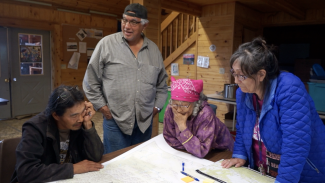Stop Ambler Road: The River Is Our Bread and Butter
27 Oktober 2024Diana

By Xiting Tong (CS intern)
“That copper mining, they use cyanide, and that’s extremely toxic. And they’re going to build a tailings pond at the top of a mountain. That tailings pond could fill up and overflow, and then we have no more good water. All that mining is upriver from us; it is going to affect the whole watershed. Our river—that’s our bread and butter,” says Shield Downey, First Chief of the Ambler Tribal Council, voicing his discontent with the proposed Ambler Access Project due to concerns about severe environmental degradation that was likely to occur after the construction.
The Ambler Access Project was proposed in 2014 by the Alaska Industrial Development and Export Authority. It would be a private industrial access road funded and constructed by the State of Alaska across traditional Tribal lands to create access to and facilitate the development of the Ambler Mining District, which has deposits of copper, zinc, and cobalt. As planned, it would have been one of the biggest and most destructive mining projects in the state’s history, intersecting 11 major river systems along with numerous smaller rivers, streams, and wetlands. The project would also severely damage the spawning and rearing habitats and migration paths of summer chum due to the effects of roads, culverts, dust, pollution, and other disturbances to the riparian areas. The wildlife and these habitats are all crucial to sustaining the way of life of the Indigenous Peoples living there.
Mineral exploration in the area is already ongoing, and additional proposed mineral development projects are imminent. In addition to environmental concerns, Native communities are worried that the access road would eventually become a public road, bringing in outside hunters, tourists, and others, making it feasible for further mining developments and further impacting their resources and their People.
Due to the significant danger the construction will pose to the Native communities, the Native Village of Ambler Traditional Council have been monitoring the proposed development of Ambler Road for many years. In 2014, when the Ambler Road proposals were initiated by the State of Alaska, the Council increased their efforts and involvement. Council members attended tri-village (Ambler, Kobuk, Shungnak) meetings, and have participated in commenting and reviewing the Ambler Road proposals since that time. They also sponsored the Kuuvanmiut Tribal Conservation District in 2014 by entering into an agreement with the U.S. Department of Agriculture to assist in coordinating and administering USDA programs related to community development, natural resources management, and conservation programs.
Despite the Council’s efforts, many others in the region who stood to be affected by the Ambler Road were not being adequately heard or informed about its development. Their concerns were ignored by multiple agencies, including the NANA Regional Corporation (a for-profit Alaska Native Corporation formed as a result of the Alaska Native Claims Settlement Act passed by Congress in 1971), the State of Alaska, and the federal government. In spite of frequent protests, the construction of the road was approved under the Trump administration in 2020.

Ivisaapaagmiit lands within 10 miles of the proposed Ambler Road
The project’s approval is not the end of the story, however. With assistance from the Keepers of the Earth Fund, the Council traveled to Juneau, AK and Washington, D.C. to meet with state and federal legislators, as well as other agencies responsible for the proposed Ambler Access Project to apprise them of how the road and mining activities would adversely impact their Tribal lands, life ways, and culture.
In May 2023, 16 council members traveled to Washington where they attended multiple federal agency meetings and met with top officials at the White House Council on Environmental Quality, the Environmental Protection Agency, Bureau of Land Management, U.S. Army Corps of Engineers, and Department of the Interior. Chief Downey met with U.S. Sen. Lisa Murkowski of Alaska and U.S. Rep. Mary Sattler Peltola, who is Alaska Native. From March 2023 to January 2024, the Council regularly submitted written comments and participated in meetings for government-to-government consultation about the Tribe’s concerns. They kept other council members and Tribes informed throughout the process by holding council meetings in Ambler and in Anchorage.
The Council’s effort paid off. As a result of the collective resistance from Indigenous communities, environmentalists, and other activists, the Ambler Access Project was called off earlier this year, citing negative environmental impacts of the road. The Council is grateful to have actively participated in fighting against the project and to have made their voice heard by Washington, thus protecting the Indigenous Peoples living along the proposed route.
Top photo: Village of Ambler Traditional Council members study a map of the proposed Ambler Road
In 2023, the Native Village of Ambler Traditional Council received a Keeper of the Earth Fund grant to support their work. KOEF is an Indigenous-led fund within Cultural Survival designed to support the advocacy and community development projects of Indigenous Peoples. Since 2017, KOEF has funded 310 projects in 41 countries through small grants totaling $1,603,307 and provided technical assistance benefiting 328 Indigenous Peoples. KOEF provides grassroots Indigenous-led communities, organizations, and traditional governments to support their self-determined development projects based on Indigenous values. Predicated on the United Nations Declaration on the Rights of Indigenous Peoples, Cultural Survival uses a rights-based approach in our grantmaking strategies to support Indigenous grassroots solutions through the equitable distribution of resources to Indigenous communities.
